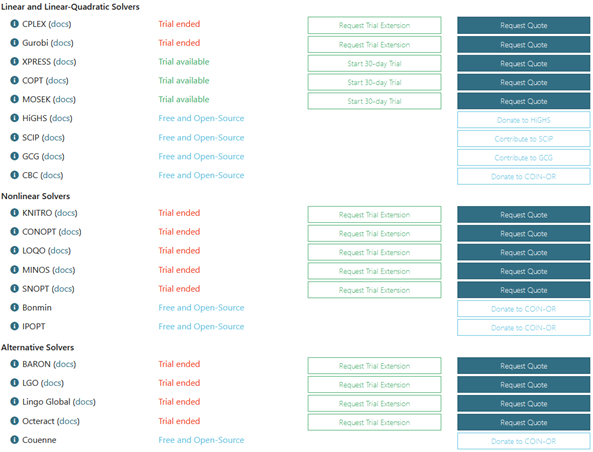
DOI:
https://doi.org/10.14483/23448393.22049Publicado:
2024-11-11Número:
Vol. 29 Núm. 3 (2024): Septiembre-diciembreSección:
Ingeniería Eléctrica, Electrónica y TelecomunicacionesComparative Analysis of the Julia and AMPL Computational Tools Used in the Radial Distribution Network Optimization Problem
Análisis comparativo de las herramientas computacionales Julia y AMPL utilizadas en el problema de optimización de redes de distribución radiales
Palabras clave:
mathematical optimization, distribution power networks, solvers, optimal capacitor placement, optimal distributed generation allocation (en).Palabras clave:
optimización matemática, redes de distribución eléctrica, solucionadores, colocación óptima de condensadores, asignación óptima de generación distribuida (es).Descargas
Resumen (en)
Context: Research on the development of mathematical models to optimize electric power distribution systems has become increasingly important in recent years. Choosing the right optimization tools and solvers to address optimization problems in these systems has therefore become fundamental.
Method: Nonlinear and mixed-integer nonlinear mathematical models addressing optimal capacitor placement and the allocation of distributed generation were implemented in the AMPL and Julia platforms. These models together with the Ipopt, Knitro, and Bonmin solvers, were tested and compared using 33-, 69-, and 83-bus test systems.
Results: The comparative analysis shows that AMPL allows for a more direct and adequate implementation of this type of optimization problem, while Julia requires more elaborate constructions. The experimental results show significant reductions in system losses through optimal capacitor and distributed generation placement.
Conclusions: AMPL offers a faster learning curve and a syntax that is more suitable for mathematical modeling. On the other hand, Julia provides superior versatility and access to a wider diversity of solvers. Although the evaluated nonlinear solvers proved to be suitable for the non-convex models and reached equivalent solutions, Knitro, a commercial solver, exhibited shorter processing times. In this sense, choosing between free or commercial alternatives involves a compromise between processing times and the available budget. Furthermore, solving the aforementioned optimization problems effectively minimized losses in the test systems. These models are basic versions that can be extended to more complex optimization problems.
Resumen (es)
Contexto: La investigación sobre el desarrollo de modelos matemáticos para optimizar los sistemas de distribución de energía eléctrica ha cobrado cada vez más importancia en los últimos años. La selección de las herramientas de optimización y solvers adecuados para resolver los problemas de optimización en estos sistemas se ha vuelto fundamental.
Método: Se implementaron modelos matemáticos no lineales y no lineales de enteros mixtos para abordar la ubicación óptima de capacitores y generación distribuida en las plataformas AMPL y Julia. Estos modelos, junto con los solvers Ipop, Knitro y Bonmin, fueron evaluados y comparados utilizando sistemas de prueba de 33, 69 y 83 barras.
Resultados: El análisis comparativo evidencia que AMPL permite una implementación más directa y adecuada para este tipo de problemas de optimización, mientras que Julia requiere construcciones más elaboradas. Los resultados experimentales evidencian reducciones significativas en las pérdidas del sistema mediante la ubicación optima de capacitores y generación distribuida.
Conclusiones: AMPL ofrece una curva de aprendizaje más rápida y una sintaxis más adecuada para el modelado matemático. Por otro lado, Julia proporciona una versatilidad superior y acceso a una diversidad más amplia de solvers. Aunque los solvers no lineales evaluados resultaron adecuados para los modelos no convexos y alcanzaron soluciones equivalentes, Knitro, un solver comercial, presentó tiempos de procesamiento más cortos. En este sentido, elegir entre alternativas gratuitas o comerciales implica un compromiso entre los tiempos de procesamiento y el presupuesto disponible. Además, la solución de los problemas de optimización mencionados permitió minimizar de manera efectiva las perdidas en los sistemas de prueba. Estos modelos son versiones básicas que pueden ampliarse a problemas de optimización más complejos.
Referencias
R. Dos Reis Gonçalves, “Modelos de programação linear inteira Mista para resolver problemas de Otimização de sistemas de distribuição de Energia elétrica radiais,” PhD thesis, Dept. Electrical Eng., Universidade Estadual Paulista, Ilha Solteira, BRA 2013. [Online]. Available: https://repositorio.unesp.br/items/bd089af3-8e0b-4ee7-a33b-d7f7a42a4170
L. A. Gallego Pareja, J. M. Lopez Lezama, and O. Gomez Carmona, “Optimal placement of capacitors, voltage regulators, and distributed generators in electric power distribution systems,” Ingeniería, vol. 25, no. 3, pp. 334-354, Oct. 2020. https://doi.org/10.14483/23448393.16925
A. Karbowski and K. Wyskiel, “Comparative study of AMPL, Pyomo and JuMP optimization modeling languages on a flood control problem example,” Pomiary Automatyka Robotyka, vol. 25, no. 4, pp. 19-24, Dec. 2021. https://doi.org/10.14313/par_242/19
I. Dunning, J. Huchette, and M. Lubin, “JuMP: A Modeling Language for Mathematical Optimization,” SIAM Rev., vol. 59, no. 2, pp-295-320, Sep. 2017. https://doi.org/10.1137/15M1020575
M.-B. Lucioograndinetti and A. Editors, “Springer proceedings in mathematics & statistics,” 2014. [Online]. Available: http://www.springer.com/series/10533
R. Anand, D. Aggarwal, and V. Kumar, “A comparative analysis of optimization solvers,” J. Stat. Manag. Syst., vol. 20, no. 4, pp. 623-635, Jul. 2017. https://doi.org/10.1080/09720510.2017.1395182
L. A. Gallego, J. M. López-Lezama, and O. G. Carmona, “A mixed-integer linear programming model for simultaneous optimal reconfiguration and optimal placement of capacitor banks in distribution networks,” IEEE Access, vol. 10, pp. 52655-52673, 2022. https://doi.org/10.1109/ACCESS.2022.3175189
J. C. Hoyos Vallejo, “Análisis de herramientas computacionales libres utilizadas en el modelado y en la solución del problema de optimización en la ubicación de capacitores y de la generación en redes de distribución radiales,” Undergraduate Thesis, Dept. Engineering, Universidad Autónoma de Occidente, Cali, Colombia, 2023. [Online]. Available: https://red.uao.edu.co/handle/10614/15108
Norma Técnica: Calidad de la potencia de redes de distribución, Empresas Públicas de Medellín, Colombia, 2019, pp.11-12.
J. C. Hoyos, “Repositorio código AMPL - JuMP.” [Online]. Available: https://github.com/camilohoyos0499/Code
“Documentation for JuMP,” JuMP. [Online]. Available: https://jump.dev/JuMP.jl/stable/
R. Fourer, D. M. Gay, and B. W. Kernighan, “AMPL: A modeling language for mathematical programming, second edition,” 2003. [Online]. Available: https://vanderbei.princeton.edu/307/textbook/AMPLbook.pdf
Cómo citar
APA
ACM
ACS
ABNT
Chicago
Harvard
IEEE
MLA
Turabian
Vancouver
Descargar cita
Licencia
Derechos de autor 2024 Juan Camilo Hoyos Vallejo, Jaime Quintero Restrepo

Esta obra está bajo una licencia internacional Creative Commons Atribución-NoComercial-CompartirIgual 4.0.
A partir de la edición del V23N3 del año 2018 hacia adelante, se cambia la Licencia Creative Commons “Atribución—No Comercial – Sin Obra Derivada” a la siguiente:
Atribución - No Comercial – Compartir igual: esta licencia permite a otros distribuir, remezclar, retocar, y crear a partir de tu obra de modo no comercial, siempre y cuando te den crédito y licencien sus nuevas creaciones bajo las mismas condiciones.



2.jpg)











